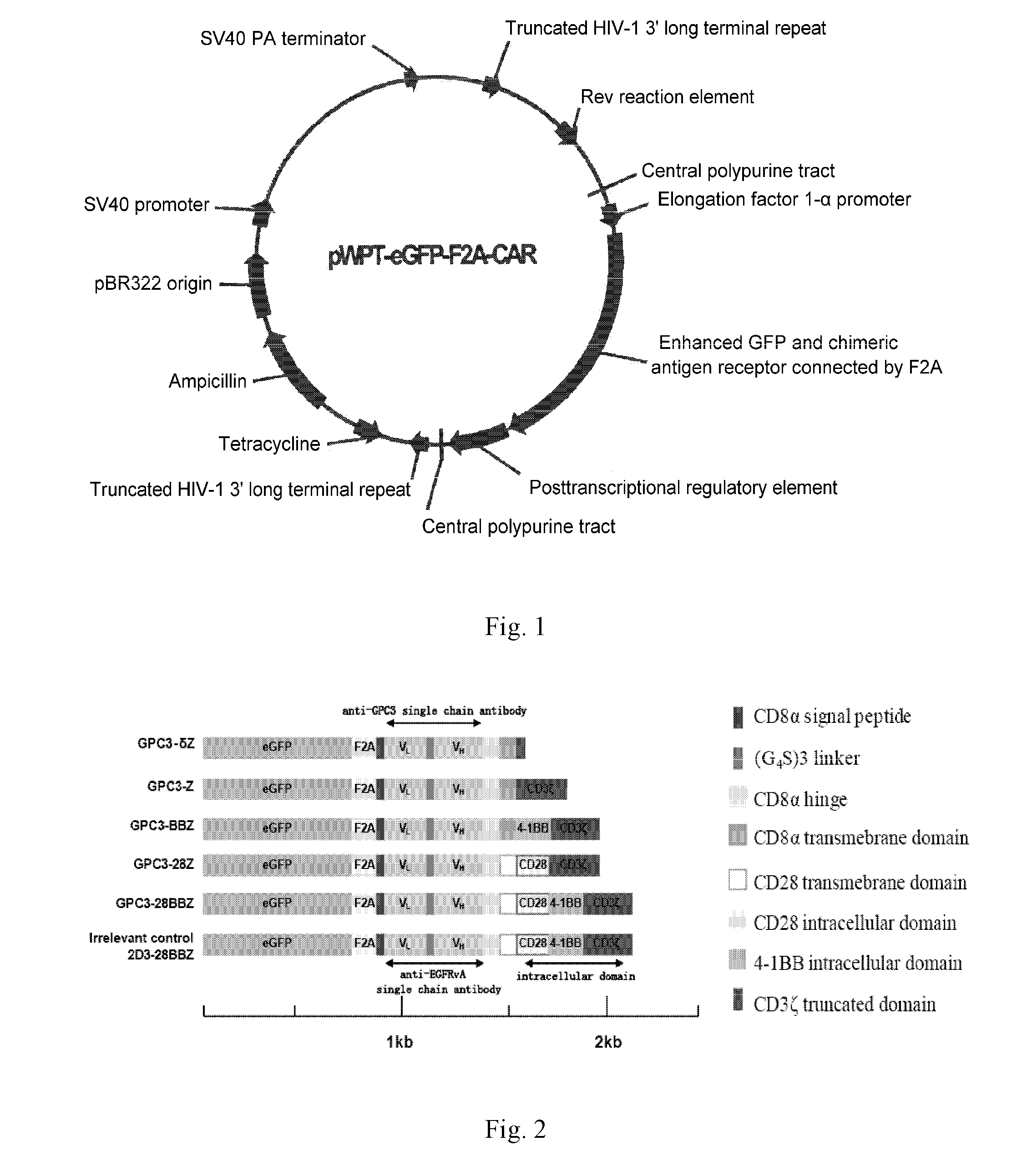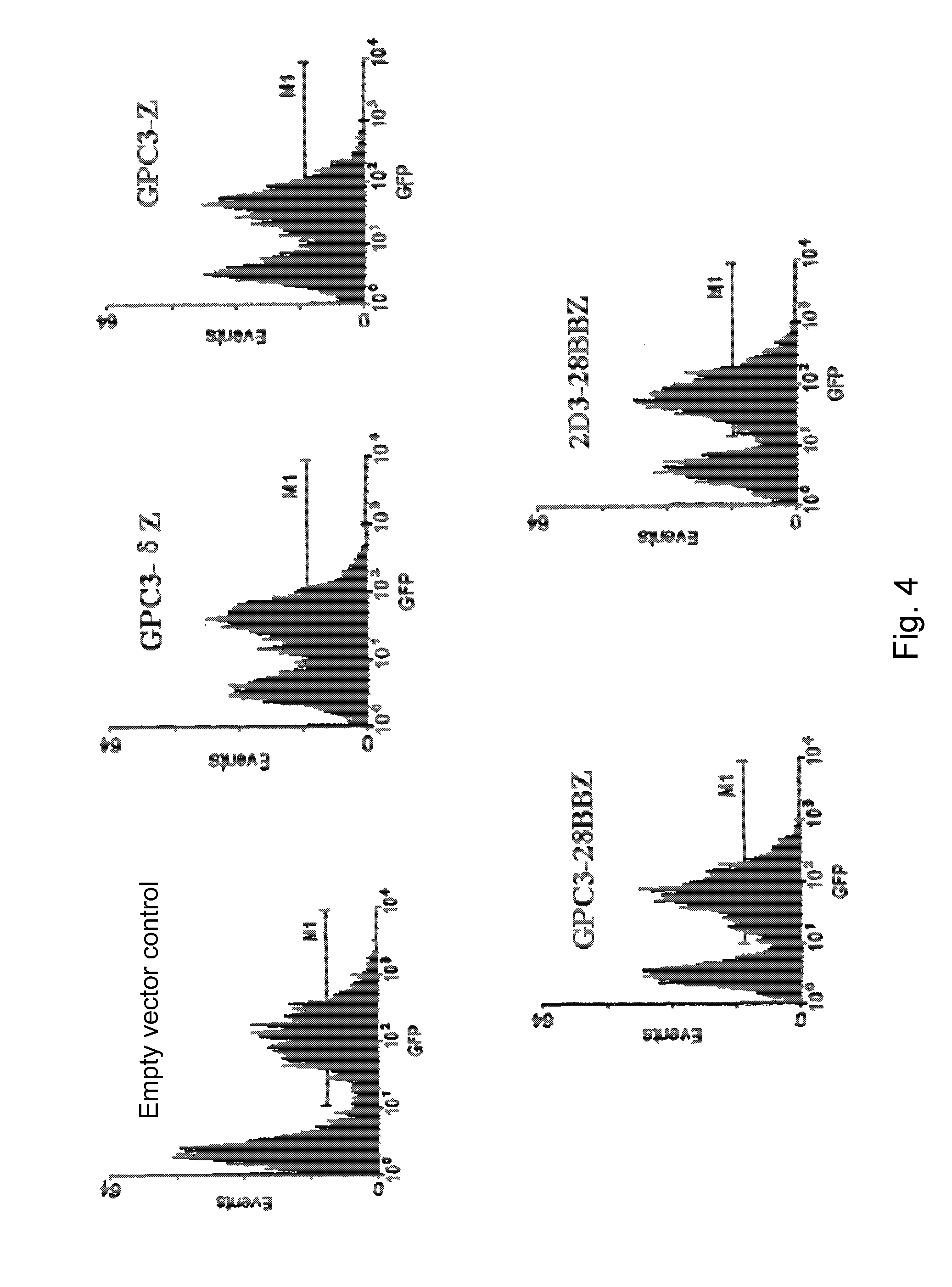Nucleic Acid Of Coded GPC3 Chimeric Antigen Receptor Protein And T Lymphocyte Expressing GPC3 Chimeric Antigen Receptor Protein
a technology of chimeric antigen receptor and nucleic acid, which is applied in the field of cell therapy for tumors, can solve the problems of increasing the treatment cost of patients, unwilling termination of treatment, and the risk of allergic reaction of therapeutic antibodies in vivo, so as to improve the in vivo survival period and antitumor effect of car t lymphocytes
- Summary
- Abstract
- Description
- Claims
- Application Information
AI Technical Summary
Benefits of technology
Problems solved by technology
Method used
Image
Examples
example 1
Construction of Lentiviral Plasmid Expressing the Chimeric Antigen Receptor of this Invention, and Virus Packaging
[0049]Table 1 below provides exemplified order of connecting various parts of the chimeric antigen receptor of this invention, the illustration shown in FIG. 2 could be referred to for such connection as well.
TABLE 1ChimericExtracellular binding domain - transmembraneantigenregion - intracellular signaling domain 1 -receptorintracellular signaling domain 2 etcDescriptionGPC3-δZscFv(GPC3)-CD8-CD3δzetaNegativeControlGPC3-ZscFv(GPC3)-CD8-CD3 zeta1stgenerationGPC3-scFv(GPC3)-CD8-CD137-CD3 zeta2ndBBZgenerationGPC3-28ZscFv(GPC3)-CD28a-CD28b-CD3 zeta2ndgenerationGPC3-scFv(GPC3)-CD28a-CD28b-CD137-CD3 zeta3rd28BBZgeneration2D3-2D3-CD28a-CD28b-CD137-CD3 zeta3rd28BBZgeneration
[0050]1. Amplification of Nucleic Acid Fragment
[0051](1) Amplification of scFv (GPC3) Sequence
[0052]The sequence of scFv (GPC3) was amplified using nucleotide GPC3 / CD3 for bifunctional single-chain antibody co...
example 2
CTL Cells Infected with Recombinant Lentivirus
[0094]Human peripheral blood mononuclear cells were obtained from healthy human peripheral blood by density gradient centrifugation (provided by Shanghai Blood Center), from such peripheral blood mononuclear cells CTLs were obtained by a negative selection process using CTL magnetic beads sorting (Stem Cell Technologies). After sorting, CTL cells were assayed by flow cytometry for purity of the CTL cells, a positive rate of 95% is deemed suitable for the next operation. CTL cells were added into Quantum 007 lymphocyte culture medium (PAA Laboratories) to a density of 1×106 / mL, and dynabeads (Invitrogen) coated with both anti-CD3 and anti-CD28 antibodies were added to a cell: bead ratio of 1:1, and recombinant human IL-2 (Shanghai Huaxin High Biotechnology Inc.) was added to a final concentration of 100 U / mL for a stimulatory culture of 24 h. Then the CTL cells were infected by the recombinant lentivirus prepared above at an MOI of approx...
example 3
In Vitro Cytotoxicity Assay for Cells Expressing Chimeric Antigen Receptor
[0097]Target cells used in in vitro cytotoxicity tests were hepatocellular carcinoma cell lines as shown in Table 3, effector cells were the CTL cells annotated as chimeric antigen receptor positive (CAW), which are the positive cells expressing chimeric antigen receptor in FACS detection as validated in Example 2 and in vitro cultured for 12 days.
TABLE 3Tumor TypeIdentitySourceHepatocellularPLC / PRF / 5ATCC: CRL-8024carcinomaHepatocellularHep 3B2.1-7ATCC: HB-8064cancerHepaticSK-HEP-1ATCC: HTB-52adenocarcinomaHepatocellularHep G2ATCC: HB-8065cancerHepaticHuh-7RIKEN: RCB1366adenocarcinoma
[0098]Hepatocellular carcinoma cell lines HepG2, Huh-7, Hep3B, PLC / PRF / 5 and SK-HEP-1 were detected by flow cytometry and western blot for GPC3 expression levels, flow cytometry results are shown in FIG. 6A, GPC3 expression in cell was presented by Mean Fluorescence Intensity (MFI). Meanwhile, the GPC3 expression levels of each ce...
PUM
| Property | Measurement | Unit |
|---|---|---|
| Nucleic acid sequence | aaaaa | aaaaa |
Abstract
Description
Claims
Application Information
 Login to View More
Login to View More - R&D
- Intellectual Property
- Life Sciences
- Materials
- Tech Scout
- Unparalleled Data Quality
- Higher Quality Content
- 60% Fewer Hallucinations
Browse by: Latest US Patents, China's latest patents, Technical Efficacy Thesaurus, Application Domain, Technology Topic, Popular Technical Reports.
© 2025 PatSnap. All rights reserved.Legal|Privacy policy|Modern Slavery Act Transparency Statement|Sitemap|About US| Contact US: help@patsnap.com



